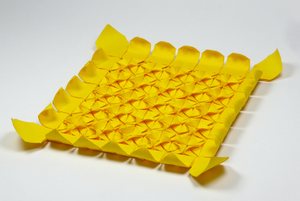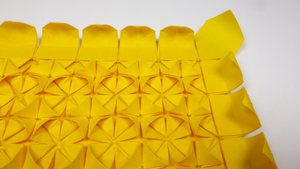Sunflower Tessellation


My new tessellation design, folded from a single sheet of Tant paper.
I wanted the edges to be something more interesting than just straight paper pleats, so I designed petals which I think are a more unique part of this model than the tessellation molecules themselves. While originally inspired by the edges of Shuzo Fujimoto’s Clover Folding, these petals are much more complex, and correspondingly require more paper (a 5 grid unit wide margin along each edge). As you can see, in contrast to the petals in Clover Folding, they are quite well separated from each other. They are also as thick as the molecules, so they form a part of the tessellation in their own right rather than just a backdrop upon which molecules rest. There is a somewhat contrived locking mechanism which causes these petals to hold together any loose paper pleats one would normally get at the edges of molecules. It took me four different designs before I had a solution which satisfied me: everything was tightly connected and no flap was loose (at the cost of the collapse being rather complex).
The same petal design can also work with Four-Sink Base molecules and others which have the same arrangement of pleats at the edges. It should be possible to adapt this idea to some other edge pleat configurations as well.
The tessellation molecule is folded from a 6×6 grid and there are 5×5 molecules in this model. The complete grid was 40×40 (2⋅5 for the margins + 5⋅6 for the central molecules). This can be scaled up or down depending on how complex a sunflower you want to make. A Mini-Sunflower with just a single molecule can be made from the convenient 16×16 grid.
I don’t normally measure the time things take me to fold, but in this case I recorded some statistics (not counting design, test folds and failed clean folds I tried before I succeeded, and the time needed for wet squashing phase which does not require the folder’s presence): 5.5 h for the precrease, 1.25 h collapsing the central part (regular molecules), 1.25 h collapsing the petals, 0.75 h modelling — almost 9 h total.
Later, I made a better fold of this model.
Comments